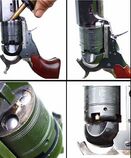Engineering:Caplock mechanism
The caplock mechanism, percussion lock, or cap and ball was the successor of the flintlock mechanism in firearm technology, and used a percussion cap struck by the hammer to set off the main charge, rather than using a piece of flint to strike a steel frizzen.
Design
thumb|Detail of the firing mechanism on an instruction cutaway model of a French navy percussion pistol, model 1837
The caplock mechanism consists of a hammer, similar to the cock used in a flintlock, and a nipple (sometimes referred to as a "cone"), which holds a small percussion cap. The nipple contains a tube which goes into the barrel. The percussion cap contains a chemical compound called mercuric fulminate or fulminate of mercury, whose chemical formula is Hg(ONC)2.[1] It is made from mercury, nitric acid and alcohol. When the trigger releases the hammer, it strikes the cap, causing the mercuric fulminate to explode. The flames from this explosion travel down the tube in the nipple and enter the barrel, where they ignite the main powder charge.[1]
History
Origins
The rudimentary percussion system was invented in Scotland by Reverend Alexander John Forsyth as a solution to the problem that birds would startle when smoke puffed from the powder pan of his flintlock shotgun, giving them sufficient warning to escape the shot.[1] His invention of a fulminate-primed firing mechanism deprived the birds of their early warning system, both by avoiding the initial puff of smoke from the flintlock powder pan, as well as shortening the interval between the trigger pull and the shot leaving the muzzle. Forsyth patented his "scent bottle" ignition system in 1807. However, it was not until after Forsyth's patents expired that the conventional percussion cap system was developed. Joseph Manton invented a precursor to the percussion cap in 1814, comprising a copper tube that detonated when crushed.[2] This was further developed in 1822 by the artist Joshua Shaw, as a copper cup filled with fulminates.[3]
The caplock offered many improvements over the flintlock. The caplock was easier to load, more resistant to weather, and was much more reliable than the flintlock. Many older flintlock weapons were later converted into caplocks so that they could take advantage of this increased reliability.[1]
Developments
thumb|A pair of caplock twister pistols
The first purpose built caplock guns were fowling pieces commissioned by sportsmen in Regency era England. Due to the mechanism's compactness and superior reliability compared to the flintlock, gunsmiths were able to manufacture pistols and long guns with two barrels. Early caplock handguns with two or more barrels and a single lock are known as turn-over or twister pistols, due to the need to manually rotate the second barrel to align with the hammer. Pocket sized versions of this pistol were widely used by gamblers in the Old West. With the addition of a third barrel, and a ratchet to mechanically turn the barrels while cocking the hammer, these caplock pistols evolved into the pepperbox revolver during the 1830s.[4]
Military use
thumb|Japanese samurai's matchlock converted to percussion
From the 1830s onwards, the armies of Britain, France, Russia, and America began converting their muskets to the new percussion system. The Americans' breech loading caplock Hall rifles, muzzle loading rifled muskets and Colt Dragoon revolvers gave them an advantage over the smoothbore flintlock Brown Bess muskets used by Santa Anna's troops during the Mexican War. In Japan, matchlock pistols and muskets were converted to percussion from the 1850s onwards, and new guns based on existing designs were manufactured as caplocks.[5]
The Austrians instead used a variant of Manton's tube lock in their Augustin musket until the conventional caplock Lorenz rifle was introduced in 1855, and the Prussians replaced their muzzle loading flintlock Potsdam muskets with the bolt action Dreyse needle gun in 1841.[6] The needle gun originally fired paper cartridges containing a bullet, powder charge and percussion cap, but by the time of the Franco-Prussian War this had evolved into modern brass ammunition.[7]
Further evolution
After the American Civil War, Britain, France and America began converting existing caplock guns to accept brass rimfire and centrefire cartridges. For muskets such as the 1853 Enfield and 1861 Springfield, this involved installing a firing pin in place of the nipple, and a trapdoor in the breech to accept the new bullets. Examples include the Trapdoor Springfield, Tabatiere rifle, Westley Richards and Snider Enfield conversions. The British army used Snider Enfields contemporaneously with the Martini-Henry rifle until the .303 bolt action Lee-Metford repeating rifle was introduced in the 1880s. Later, military surplus Sniders were purchased as hunting and defensive weapons by British colonists and trusted local natives.[8][9]
Caplock revolvers such as the Colt Navy and Remington were also widely converted during the late 19th century, by replacing the existing cylinder with one designed for modern ammunition. These were used extensively by the Turks in the Russo-Turkish War, the US Cavalry during the Indian Wars, and also by gunfighters, lawmen and outlaws in the Old West.[10]
See also
- Arquebuse
- Cap gun
- Internal ballistics
- Minié ball
- Tubes and primers for ammunition
References
- ↑ 1.0 1.1 1.2 1.3 Fadala, Sam (17 November 2006). The Complete Blackpowder Handbook. Iola, Wisconsin: Gun Digest Books. pp. 159–161. ISBN 0-89689-390-1. https://books.google.com/books?id=Dzxyneq43AEC&pg=PA160.
- ↑ Sam Fadala (2006). The Complete Blackpowder Handbook. Krause Publications. p. 158. ISBN 978-0-89689-390-0. https://books.google.com/books?id=Dzxyneq43AEC&pg=PA158.
- ↑ "Joshua Shaw". http://www.researchpress.co.uk/firearms/ignition/shaw02.htm. Retrieved 2018-11-05.
- ↑ Martin J. Dougherty (2017). Pistols and Revolvers: From 1400 to the present day. Amber Books Ltd. p. 53. ISBN 978-1-78274-266-1. https://books.google.com/books?id=MloqDwAAQBAJ&pg=PT53.
- ↑ "Met Museum". Met Museum. https://www.metmuseum.org/art/collection/search/24491. Retrieved 2018-11-05.
- ↑ "Kammerbusche". Militarygunsofeurope.eu. http://militarygunsofeurope.eu/listing/austrian-m1842-kammerbuchse/. Retrieved 2018-11-05.
- ↑ Dreyse needle gun
- ↑ "Loading and firing a Snider Enfield". Militaryheritage.com. http://www.militaryheritage.com/snider.htm. Retrieved 2018-11-05.
- ↑ "Britain's big 577". Thefreelibrary.com. https://www.thefreelibrary.com/Britain's+big+.577+Snider.-a0141344134. Retrieved 2018-11-05.
- ↑ "Colt revolver in the Old West". http://theautry.org:80/the-colt-revolver-in-the-american-west/forced-to-adapt. Retrieved 2018-11-05.
External links







